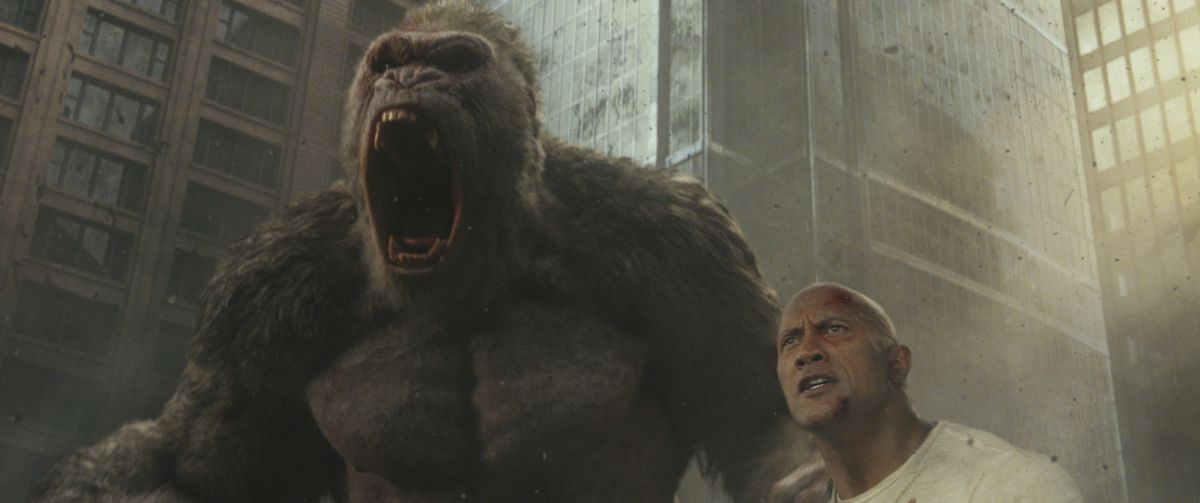When David Liu, a professor of chemistry and chemical biology at Harvard, first saw the trailer for the latest Dwayne “The Rock” Johnson movie Rampage, he rolled his eyes. Liu has been working with the gene-editing tool CRISPR for about six years, developing a gene therapy that might one day treat human hearing loss, among other things. In Rampage, a rogue CRISPR experiment is responsible for turning a gorilla, a wolf, and a crocodile into huge, savage monsters. When Liu saw the trailer in a movie theatre, he chuckled and said out loud, “Seriously?”
Yes, seriously. Rampage is a dumb action movie that features unbelievably indestructible monsters, an equally indestructible Dwayne Johnson, and several mentions of CRISPR. Though some scientists like Liu are excited to see Hollywood feature the groundbreaking technology they work with every day, others are worried that inaccurate portrayals in movies like Rampage might give people unfamiliar with CRISPR the wrong idea of what the tech is capable of doing. (A caveat: None of the people I interviewed for this story have seen Rampage. Some plan to; others are not so sure. “I don’t know if it’d just make me mad,” says Mitchell O’Connell, an assistant professor in the Department of Biochemistry and Biophysics at the University of Rochester.)
First, let’s get this out of the way: CRISPR can’t be used to turn wolves into gigantic, flying monsters that can shoot porcupine spines off their tails. It can be used to precisely edit DNA, and scientists are trying to engineer the tech to cure some of the most horrible diseases out there, like cancer and sickle cell anemia. But the whole premise of the movie — that some sort of weaponized CRISPR concoction can infect animals and change their bodies as well as their behavior — is incredibly far-fetched. There are just too many genes, many of them unknown, that influence traits like body size and shape, and there’s currently no way to simultaneously edit hundreds of thousands of genes all over the body, Liu tells The Verge.

“There will never be, because it’s biologically impossible, a simple single-dose way to make an animal suddenly sprout wings or become huge and aggressive or turn into King Kong,” he says.
But what if a movie viewer has never heard of CRISPR? Rampage opens with the following documentary-style statements: “In 1993, a breakthrough new technology, known as CRISPR, gave scientists a path to treat incurable diseases through genetic editing. In 2016, due to its potential for misuse, the US Intelligence Community designated genetic editing a ‘Weapon of Mass Destruction and Proliferation.’” Though the latter is accurate, scientists weren’t using CRISPR to edit DNA in 1993; it wasn’t even called CRISPR until much later, STAT reports. Everything that follows that title screen is total science fiction.
The writers are certainly aware of that — everything in the movie is over the top — but studies have shown that cinema and television can affect our perception of science. Research in the 1980s, for instance, showed that the more TV people watched, the less highly they thought of science, possibly because scientists have historically been portrayed as villains. Since then, representation in media has gotten better, says Dietram Scheufele, a science communication scholar at the University of Wisconsin-Madison. That’s in part due to programs like the Science & Entertainment Exchange, which was created in 2008 by the National Academy of Sciences to “push Hollywood beyond the boring ‘evil scientist’ stereotype,” says Megan Hochstrasser, the science communications manager at the Innovative Genomics Institute.
Still, there’s lots of work to be done. “Scary, ridiculous depictions of science are still ubiquitous,” Hochstrasser tells The Verge in an email. Most scientific research happens in universities, not in basements and secret warehouses, and the scientists “typically make a pretty measly salary” and are mostly motivated by “a desire to make the world a better place,” she says. But stereotypes run deep: Scheufele says that when he asks his students — some of them in STEM fields — for five words to describe a scientist, those five words are usually “male,” “white,” “old,” “crazy hair,” and “glasses.” Or, as Scheufele says, a mix between Bill Nye and Doc from Back to the Future. (That’s also typically how children depict scientists when asked to draw one.)

Films often also overstate the power of technology for dramatic effect, whether scientists are using nukes to jumpstart the Earth’s magnetic field in The Core, creating clones with genetic memories of their DNA donors in Alien 3, or converting harvested blood cells into live dinosaurs in the Jurassic Park films. This is why O’Connell says he wasn’t surprised to finally see a movie featuring CRISPR. “I guess it was just a matter of time,” he tells The Verge. “Hollywood loves to jump on new and potentially scary technologies.”
Hollywood isn’t solely at fault, either. In a 2016 X-Files episode, aliens use CRISPR to destroy humans’ immune systems, which quickly kills them. By contrast, Altius Institute for Biomedical Science associate director Fyodor Urnov spent years trying to develop a therapy for people born without immune systems. “For me, there was deep, poignant, almost painful irony that here is this technology on TV, and what is it used for? It is used by an alien conspiracy to make people immune-deficient,” says Urnov.
O’Connell worries that Rampage audiences who don’t know what CRISPR is might misunderstand what the technology can do. “The movie is trying to be tongue in cheek, but it assumes people understand the joke. I don’t think most people do,” he says. Urnov, who’s worked with gene editing for more than a decade, has similar worries, especially about the X-Files episode. “The fact that biotechnology is a force for evil and a tool for villains, that is a concern,” he tells The Verge. “Because in the real world today, biotechnology can be and is a force of tremendous good.”
In China, doctors are using CRISPR to edit the immune cells of a patient with lung cancer, to help him defeat the disease. In America, a different technique is being used in an attempt to edit a man’s DNA and cure him of a genetic disorder called Hunter syndrome. The technology is also being used to create cheap diagnostics to detect infections like HPV, dengue, and Zika. So when CRISPR is used in movies to genetically transform crocodiles into enormous, savage creatures, that misses the point, Urnov says.
But Scheufele says the scientific community tends to worry too much about how movies, and other media, shape people’s perception of technology. In the early 2000s, when Michael Crichton published the book Prey, about a swarm of nanobots taking over the world, some in the scientific community were “freaking out,” Scheufele says. But the book — as well as Prince Charles’ calls for British scientists to look into the “enormous environmental and social risks” of nanotechnology — didn’t end up turning public opinion against the tech based on doomsday scenarios. In fact, scientists were more worried than the public about how nanotechnology might affect health and the environment, according to a study Scheufele published in 2007.

One movie isn’t going to turn people against CRISPR, Scheufele says. But if more movies start showing gene-editing as a tool for mass destruction, the scientific community might have a problem. For now, though, a film like Rampage might actually do some good; it might let more people know that CRISPR exists. “It’s a great thing if emerging science is discussed in entertainment media,” he says. “In fact, it’s a great way to reach an audience.” Liu agrees, as long as movie viewers realize that what they’re watching is fiction and not fact.
“In a sense, it’s flattering that Hollywood is interested in CRISPR technology enough to make it the premise of a movie,” Liu says. It’s even more flattering for scientists who are fans of the people in those movies. “If The Rock is really interested in learning more about CRISPR, you can tell him to reach out to me,” Liu adds. “I’m happy to give him a CRISPR lecture.”
https://www.theverge.com/2018/4/18/17248402/rampage-crispr-gene-editing-technology-hollywood-science-representation

